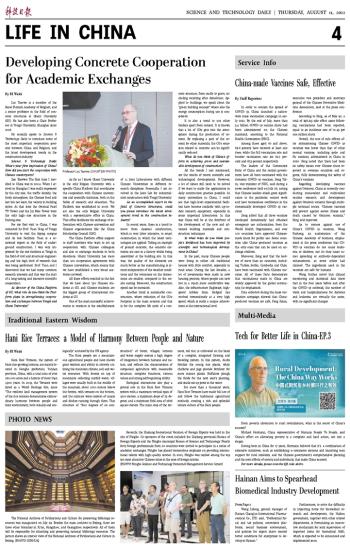
 |
| Professor Luc Taerwe. (COURTESY PHOTO) |
Luc Taerwe is a member of the Royal Flemish Academy of Belgium, and a senior professor in the field of concrete structures at Ghent University (GU). He has also been a Chair Professor at Tongji University, Shanghai since 2018.
He recently spoke to Science & Technology Daily to introduce some of the most important cooperation projects between China and Belgium, and the latest development trends in the construction industry.
Science & Technology Daily: What's your first impression of China? How did you start the cooperation with Chinese counterparts?
Luc Taerwe: The first time I travelled to China was in 2004. When I arrived in Shanghai I was really impressed by the city size, the traffic density, the lively atmosphere, the Chinese food and last but not least, the variety in building styles. At that time the Oriental Pearl TV Tower and the Jin Mao Tower were the only high-rise structures in the Pudong area.
For my first visit to China, I was contacted by Prof. Yuan Yong of Tongji University to visit the Siping campus and its test facilities. Yuan is a renowned expert in the field of underground construction. I was very impressed by the test facilities at Tongji in the field of civil and structural engineering and the high level of research that was being performed. Prof. Yuan and I discovered that we had many common research interests and this was the start of a long-lasting and intensive scientific cooperation.
As director of the China Platform of GU, what role do you think the Platform plays in strengthening cooperation and exchanges between Tongji and Ghent University?
As far as I know, Ghent University is the only Belgian University with a specific China Platform that coordinates the cooperation with Chinese universities and scientific institutes, both in the fields of research and education. The Platform was established in 2006. We are also the only Belgian University with a representative office in China. This office facilitates the exchange of information with Chinese universities and Chinese organizations like the China Scholarship Council (CSC).
The China Platform offers support to staff members who want to set up cooperation with Chinese colleagues and also to exchange students in both directions. Ghent University has more than 100 cooperation agreements with Chinese universities,which means that we have established a very broad academic network.
All these efforts resulted in the fact that we have about 750 Chinese students at GU, and Chinese students are the biggest group of international students at GU.
One of the most successful achievements to mention is the establishment of 11 Joint Laboratories with different Chinese Universities in different research disciplines. Personally, I am involved in the Joint Lab for industrialized construction with Tongji University.
As an accomplished expert in the field of Concrete Structures, could you please introduce the latest development trend in the construction industry?
In recent years, there is a trend to move from classical construction, which is very labor intensive, to smart construction in which the latest technologies are applied. Taking an example of precast concrete, the concrete elements are cast in a factory whilst being assembled at the building site. In this way, the quality of the elements are much better as the manufacturing is almost independent of the weather conditions and the tolerances on the dimensions are smaller, compared to the on-site casting. Moreover, the construction speed can be increased.
Another trend is sustainable construction, where reduction of the CO2 footprint is the main concern and this is for the complete life cycle of a concrete structure, from cradle to grave, including recycling after demolition. Applied to buildings, we speak about the "green building concept" where also the energy consumption during use is considered.
It is also a trend to use other binders apart from cement. It is known that a lot of CO2 gets into the atmosphere during the production of cement. By replacing a part of the cement by other materials, the CO2 emission related to concrete can be significantly reduced.
What do you think of China's efforts in achieving green and sustainable development of construction?
All the trends I just mentioned, are the results of recent scientific and technological developments. However, a lot of issues still need to be solved if we want to make the applications in daily construction practice possible. At many universities in China, I could see that high-level experimental facilities have become available with up-to-date research equipment, especially in some important laboratories. In this way China will be at the forefront of the development of the new and advanced building materials and construction techniques.
In what ways do you think people's livelihood has been improved by scientific and technological development in China?
In the past, many Chinese people were living in rather old traditional houses with little comfort, especially in rural areas. During the last decades, a lot of investments were made in new housing projects, where people can now live in a much more comfortable way. Also, the infrastructure (highways, high-speed railway lines, bridges) has evolved tremendously at a very high speed, which is really a unique achievement at the international level.







